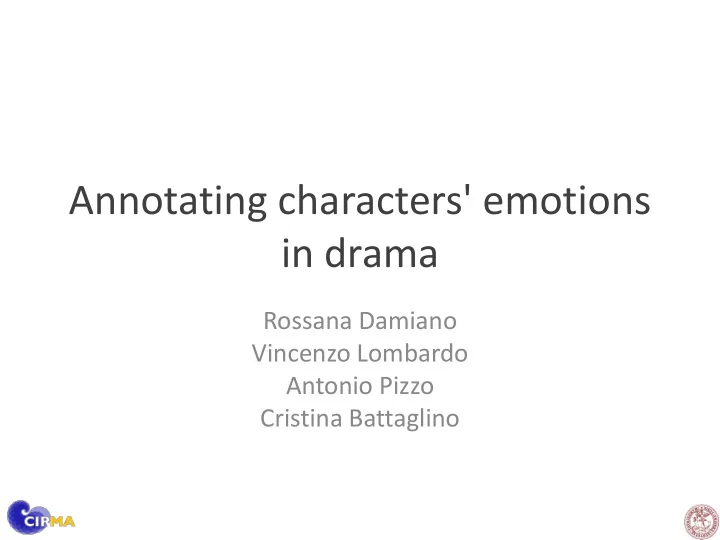

Annotating characters' emotions in drama Rossana Damiano Vincenzo Lombardo Antonio Pizzo Cristina Battaglino
Introduction • Emotions are one of the distinctive feature of drama • Annotation of narrative contents – For example, the information about characters emotions • Rule-based approach to annotate characters emotions
OCC Appraisal theory • According to appraisal theories, emotions arise from an evaluation of a situation. Compound emotions Remorse Well-being emotions Goals Evaluation of (Ditress + Self-reproach) events Joy Gratification Distress (Joy + Pride) Anger (Ditress + Reproach) Attribution emotions Evaluation of Gratitude Pride, Self-reproach actions Values (Joy + Admiration) Admiration, Reproach
Modeling emotions • In order to annotate emotions, we need to define an appraisal derivation model and an affect derivation model Appraisal Derivation Model Affect Derivation Model Situation Appraisal variables Affective State
Characters with value and goals Mental State Affective State Beliefs Derived from a set of A set of literals in first order domain-independent logic style appraisal rules based on values and goals processing Values A scale of values v 1 v 2 … v n Values at Stake V n (Vc) Goals g(Ac, Sc, Fc,)
Appraisal and Affect derivation with values Appraisal derivation model Affect derivation model Actions satisfying goals Desirability Adopted Achieved JOY goal goal Actions threating goals Undesirability Adopted Unachieved DISTRESS goal goal Actions re-establishing values Praiseworthiness PRIDE Value at Balanced value ADMIRATION Stake Actions putting at stake Blameworthiness values Balanced SELF-REPROACH Value at value stake REPROACH
Methodology • Test the model of value-based moral appraisal on stories • Translate the model into appraisal rules • Apply rules to stories to verify if congruent emotions are generated for the characters • Rely on semantically annotated stories, with SWRL rules for moral appraisal
Drammar Ontology • Character behavior encoded in a semantic format • Reuse of this knowledge in agent- based application • Drammar ontology assumes that a story can be segmented in a sequence of units
Drammar Ontology Unit hasPrecondition containsEvent / hasEffect Unit “ Where is Your Father?” featuresAgentInState enactedBy AgentInState StoryState Hamlet Consequent feels features Emotion incidentFeatures Agent AgentInUnit Anger Ophelia Ophelia_Unit intends featuresAgent Agent committedTo Hamlet owner hasValueAtStake UnitIncident GoalOfAgentInState Intends Ophelia Nunnery State ValueAtStake HonestyAtStake featuresGoal featuresProcess Action Lying atStake Goal unachiavableDueTo Intends Ophelia Nunnery Value Honesty hasValue triggers
Emotions in Drammar • Characters' emotions are established in the effects of the unit as a consequence of the appraisal process. • SWRL rules for the activation of emotions in agents. • Emotion type generated: – Well-being: joy, distress. – Attribution: pride, shame, reproach, admiration. – Compound emotions: anger, gratification, remorse, gratitude.
SWRL Rules and Appraisal SWRL Antecedent SWRL Consequent Appraisal Derivation Model Affect Derivation Model Person-enviroment relation (beliefs, Appraisal variables Affective State goals, etc.)
Distress Story State Precondition • The Distress SWRL rule Goals Achievable antecedent fires when: – an agent’s goals in the preconditions of the unit; Unit (action or – the appraised event external event) (action or external event), that makes the goal unachievable ; Goals Unachievable Story State Effect
Reproach Story State Precondition • The Reproach SWRL Balanced rule antecedent fires Value when: – an agent’s value not at stake in the someone’s else preconditions of the unit blameworthy ; action – the appraised action, executed by another agent in the unit, putting Value at the value at stake in the stake effects of the unit. Story State Effect
A compound emotion - Anger Story State Precondition Goal Balanced achievable Value someone’s Unit (action else or external blameworthy event) action Goal Value at unachievable stake Story State Effect
Example and Validation • French writer and dramatist Georges Polti • Our example is – taken from the Nunnery Scene of Hamlet, Shakespeare – Hamlet and Ophelia are the involved characters • Ophelia is sent to Hamlet by Polonius and Claudius to confirm the assumption that his madness is caused by his rejected love. In the middle of the scene Hamlet puts Ophelia on a test to verify her loyalty. Because he guesses (correctly) that the two conspirators are hidden behind the curtain, he asks the girl to reveal where her father Polonius is. She decides to lie and replies that he is at home. • We model the climactic story segment in which Ophelia decides to lie about Polonius’s location
Nunnery Scene in Drammar hasPrecondition containsEvent / hasEffect Unit “ Where is Your Father?” featuresAgentInState enactedBy AgentInState StoryState Hamlet Consequent feels features Emotion incidentFeatures Agent AgentInUnit Anger Ophelia Ophelia_Unit intends featuresAgent Agent committedTo Hamlet owner hasValueAtStake UnitIncident GoalOfAgentInState Intends Ophelia Nunnery State ValueAtStake HonestyAtStake featuresGoal featuresProcess Action Lying atStake Goal unachiavableDueTo Intends Ophelia Nunnery Value Honesty hasValue triggers
Hamlet feels Anger Story State Precondition Goal Balanced achievable Value someone’s Undesirabl else e event blameworthy action Goal Value at unachiavable stake Story State Effect
Emotion inferred by SWRL rules in Protegè
Conclusion • Relying on the notion of value, we proposed a general model of value – based appraisal of actions, an intrinsically interpersonal dimension in emotion generation. • We implemented our model as a set of SWRL rules on the top of an ontology • Through the model we propose, a range of emotional states can be elicited, depending on the agent’s subjective and shared values, and the generation of empathic emotions can be traded-off against the moral dimension of appraisal.
Recommend
More recommend